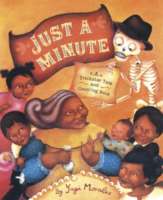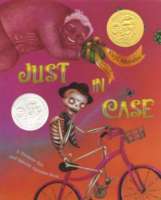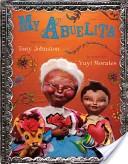Learning Language through Stories and Songs in a Multiage Preschool Classroom
by Julia López-Robertson
“Today is bridge day!”
“I know what you have in the fish bag!”
“Oooh, I see the fish bag!”
“Today is singing day! I see the abejita!”
“¿Mami, vamos a cantar hoy? ¡Yo sé que sí, yo vi la bolsa!” [Mami, are we going to sing today? I know we are. I saw the bag!”]
These excited questions and comments are from three to five year olds in Mrs. Frierson’s multiage Montessori classroom at the Spears Creek Road Child Development Center in Columbia, South Carolina. I have been with the children for almost two years during the time my son has been in this classroom, and I can usually be found reading and singing with them on Friday mornings.
The children’s comments indicate that they know what is inside the ‘fish bag’ and what happens when I bring the bag to school. The bridge that they mention refers to a song by José Luis Orozco, La vibora de la mar, which I have on a CD inside an abejita/bee CD case in my tote bag which is decorated with colorful fish. During my time with the children, we read a variety of books, sing songs, and practice finger plays in Spanish. I have shared Spanish children’s songs, books translated into Spanish (i.e. El conejito Knuffle/Knuffle Bunny) and Latino children’s literature by Latino authors and/or illustrators. I have chosen to do this in Spanish so that children,
- •Recognize the value in being bilingual.
- •See that Spanish has a place in school.
- •Learn about other cultures and languages.
- •Share my love of children’s literature in general and Latino literature in particular.
- •Experience the beauty of the Spanish language and Latino culture to plant a seed for an interest in (or life-long love) of languages and cultures.
My read alouds and songs are based on a sociocultural view of literacy where children are active participants in their learning (Vygotsky, 1978). The children are encouraged to “explore their understandings and use language for making meaning” through approximations, rather than to produce the ‘right’ answer (Freeman & Freeman, 2004, p. 9). The children are not yet proficient in the target language, but in the process of learning more Spanish they play with the language and express their ideas in a variety of ways (Freeman & Freeman, 2004). Their ideas and approximations are always celebrated.
There are twenty children, ten boys and ten girls; six kindergarteners, seven four year olds and seven three year olds. Of the twenty children in the classroom one child is Latino, one is African American and Latina, one is from India, one is Asian, eight children are African American and eight are White. The languages represented in the classroom are English, Spanish, and Tamil. While the diversity found in this classroom is representative of the population in South Carolina, it is rare for diversity to be so well represented in most South Carolina schools.
The children are fortunate to have wonderful and caring teachers with them all day. Tammy Frierson is the primary teacher, Mary Robinson is the full time Teaching Assistant, Colleen Moffatt is the afternoon teaching assistant and Rocio Herron is the morning teaching assistant and the Spanish teacher. Sra. Herron is a native of Costa Rica and shares her language and culture with the children daily on an informal basis and once a week more formally during her scheduled Spanish lesson.
Sra. Herron’s lessons connect with other areas of the curriculum which affords the children the opportunity to make connections across the day. For example, the children had been learning and talking about colors for a few weeks and were aware of the color words in both English and Spanish. One Friday, while I was reading La semana de Cookie /Cookie’s Week (Ward and dePaola, 1988) the children immediately shouted, “Cookie is a negro gato” [Cookie is a black cat]. As we continued to read the book each time Cookie appeared the children commented ‘negro gato.’ I took this teachable moment to explain the differences between the Spanish and English languages when it comes to adjective placement (in Spanish the adjective follows the noun) and before I could provide an example, one of the children added, “Oh, so this is how you say it–Cookie is a gato negro.”
Reading with the children: It’s all about Señor Calavera and ‘el gato’
 We have read and enjoyed many books and one of the children’s favorite authors (who happens to be one of mine too) is Latina author/illustrator Yuyi Morales. We’ve read and talked about all of Yuyi’s books, but decided to take a closer look at two of her books and engage in a mini author inquiry. We focused our inquiry on Just a Minute: A Trickster Tale and Counting Book (2003) and Just In Case: A Trickster Tale and Spanish Alphabet Book (2008). These books tell the adventures of Señor Calavera. The children absolutely love them and are mesmerized by Señor Calavera.
We have read and enjoyed many books and one of the children’s favorite authors (who happens to be one of mine too) is Latina author/illustrator Yuyi Morales. We’ve read and talked about all of Yuyi’s books, but decided to take a closer look at two of her books and engage in a mini author inquiry. We focused our inquiry on Just a Minute: A Trickster Tale and Counting Book (2003) and Just In Case: A Trickster Tale and Spanish Alphabet Book (2008). These books tell the adventures of Señor Calavera. The children absolutely love them and are mesmerized by Señor Calavera.
 Before reading Just In Case: A Trickster Tale and Spanish Alphabet Book, I asked the children to look at the cover and tell me what they thought the book might be about. Almost all of them commented on the ‘cute cat’ on the front cover and some guessed that there was a party because ‘she is decorating the cake.’ One of the children said “It’s a counting book,” and I asked her how she knew this. Her response was, “I read it.” One of the children pointed to Señor Calavera on the cover and shouted, “Who is that?” My son, who had already read the book, said, in a matter of fact manner, “Oh, that’s Señor Calavera. He is Grandma Beetle’s friend.” Now the focus shifted from the cake and words on the cover to Señor Calavera. Additional comments were shared about Señor Calavera’s big watch, his pretty hat, his long fingers, and then a child shouted, “He is a skeleton and it isn’t even Halloween!” With the turning of each page, children made more comments about Señor Calavera–“Look he is drinking. Where is it [the drink] going? He can’t keep it in.” “He has big teeth.” “He looks worried.”
Before reading Just In Case: A Trickster Tale and Spanish Alphabet Book, I asked the children to look at the cover and tell me what they thought the book might be about. Almost all of them commented on the ‘cute cat’ on the front cover and some guessed that there was a party because ‘she is decorating the cake.’ One of the children said “It’s a counting book,” and I asked her how she knew this. Her response was, “I read it.” One of the children pointed to Señor Calavera on the cover and shouted, “Who is that?” My son, who had already read the book, said, in a matter of fact manner, “Oh, that’s Señor Calavera. He is Grandma Beetle’s friend.” Now the focus shifted from the cake and words on the cover to Señor Calavera. Additional comments were shared about Señor Calavera’s big watch, his pretty hat, his long fingers, and then a child shouted, “He is a skeleton and it isn’t even Halloween!” With the turning of each page, children made more comments about Señor Calavera–“Look he is drinking. Where is it [the drink] going? He can’t keep it in.” “He has big teeth.” “He looks worried.”
As I read, the children caught on quickly to the pattern of Grandma Beetle saying “Just a minute, Señor Calavera, I will go with you right away, I have just…” and usually said it before I even had a chance to turn the page. “Wow, he is a good waiter,” one of the children commented, referring to the patience Señor Calavera shows while waiting for Grandma Beetle. As we continued to read the children remained focused on the brilliant and lively illustrations and then all of sudden someone yelled, “Pedro’s mommy, there is a little black cat on each page!” As soon as this comment was made, the children called for me to go back to the beginning of the book to see if there was a cat on each page.
While searching the page for the cat one of the children shared very excitedly, “I know, Yuyi Morales made a game for us. A game of hide and go seek with the gato!” The children all agreed that the author had purposely hidden the cat on each page for the children to have “extra fun while reading the book.” One of the younger children commented, “She hided the cat on every page for us to find.”
We continued reading and searching and each time as I turned the page they would yell, “I see the cat!” “Yeah, I see a gato”. “¡El gato! ¡El gato! I see the gato!” We were about half way through the book when a child said, “Wait, I have seen this cat before. We read a book about a little cat that looks like this one.” “Yeah, the gato that gets into trouble!” The others chimed in and agreed that we had seen this cat in another book. I shared with the children that I had absolutely no idea what cat or book they were talking about. I think that they were getting frustrated with me because as they continued explaining the gato to me, I still had no idea what they were talking about, until the last few comments. “You know the cat in the toilet!” “It’s Cookie! Cookie, the cat that spills water and makes a mess! You broughted that book last time!” Finally, I caught on and they were so right! Cookie, the main character in La semana de Cookie does look a lot like this little gato.
The children continued to look, listen, and talk while we read. They were intent on finding the gato on each page. Just when it seemed that the gato talk had lost interest, one of the children shared, “It’s not the same gato you know. We asked Yuyi Morales and she told us that her gato is named Frida, like Frida Kahlo, and this other cat is named Cookie so it’s not her cat. It’s not the same gato.” A few weeks prior to this discussion, Yuyi Morales had participated in a blog (wowlit.org) and answered questions and comments sent by the children. One comment from a child was about the cat: “I like your cat. I know her name is Frida because I saw the My Abuelita movie.” Yuyi replied, “Thank you for liking my cat. Yes, the cat in my abuelita’s book is Frida. You can see some more pictures of Frida on Abuelita’s Webpage www.yuyimorales.com/my_abuelita/abuelita.html.”
 We visited the webpage and found some cute pictures of Frida. This discovery led the children to wonder why the gato in Just A Minute!: A Trickster Tale And Counting Book (2003) and Just In Case: A Trickster Tale And Spanish Alphabet Book (2008) does not look like the gato in My Abuelita (Johnston, 2009) but more like the gato in Cookie’s Week. After a few minutes a child simply said, “She [Yuyi Morales] is the writer and drawer and she can do what she wants with her books.” The comment seemed to satisfy everyone and the discussion ended.
We visited the webpage and found some cute pictures of Frida. This discovery led the children to wonder why the gato in Just A Minute!: A Trickster Tale And Counting Book (2003) and Just In Case: A Trickster Tale And Spanish Alphabet Book (2008) does not look like the gato in My Abuelita (Johnston, 2009) but more like the gato in Cookie’s Week. After a few minutes a child simply said, “She [Yuyi Morales] is the writer and drawer and she can do what she wants with her books.” The comment seemed to satisfy everyone and the discussion ended.
Singing with the children: Cho-co-la-te
When I was growing up, my mamá always made chocolate [hot chocolate] on cold winter days; it was so delicious and warmed me up on the inside and out. I wanted to share a bit about my culture with the children so after a few weeks of singing Cho-co-la-te (Orozco, 1994), I told the children that we were going to make chocolate. They were so excited. I explained that my chocolate was probably different from the hot chocolate that they were used to drinking; the difference being that mine is made from chunks of chocolate and most of what they made and drank came from powder or syrup.
Chocolate day came and they were ready and excited. After heating up the milk, we cut the bars of chocolate, placed them in the pitcher and then each child took a turn stirring while we sang our song.
Cho-co-la-te
Uno, dos, tres, CHO (clap)
Uno, dos, tres CO (clap)
Uno, dos, tres, LA (clap)
Uno, dos, tres, TE (clap)
CHOCOLATE, CHOCOLATE,Bate [stir], Bate [stir], CHOCOLATE
Closing thoughts
Napoli (2003) believes that “second language learning is more successful when richly interactive language is used in the classroom” (p.19). The read alouds and songs that we engage in on weekly basis support the children’s growing development of a sense of story while also engaging them in actively learning an additional language, Spanish. During their Spanish lessons with Sra. Herron and during my read alouds and songs, the children know that in order to fully participate in the lessons and gain the most from them, they must use Spanish.
The young children in this classroom are learning the value of being bilingual while becoming bilingual and in some cases multilingual; they use Spanish on a daily basis with their teachers, peers, families, and with me and are developing the “ability to understand and produce language because language is essential for social interaction” (Freeman & Freeman, 2004, p.8). The children are learning Spanish because it is such an embedded part of their daily classroom life and because their teachers value their learning of an additional language.
References
Freeman, D. & Freeman, Y. (2004). Essential linguistics: What you need to know to teach reading, ESL, spelling, phonics, grammar. Portsmouth, NH: Heinemann
Johnston, T. (2009). My Abuelita. Boston, MA: Harcourt Children’s Book.
Morales, Y., (2003). Just A Minute!: A Trickster Tale And Counting Book . San Francisco, CA.: Chronicle Books
Morales, Yuyi, (2008). Just In Case: A Trickster Tale And Spanish Alphabet Book. New York, N.Y.: Roaring Book Press
Napoli, D. J. (2003). Language matters: A guide to everyday questions about language. Cambridge, MA: Oxford University Press.
Orozco, J.L. (1994). De colores and other Latin-American folk songs for children. New York: Puffin Books.
Vygotsky, L. (1978). Mind in society. Cambridge, MA: Harvard University Press. Ward, C. & dePaola, T. (1988). La semana de Cookie. New York: Scholastic.
Julia López-Robertson is an Assistant Professor of Language and Literacy at the University of South Carolina.
WOW Stories, Volume III, Issue 1 by Worlds of Words is licensed under a Creative Commons Attribution-NonCommercial-ShareAlike 4.0 International License.
Based on a work at https://wowlit.org/on-line-publications/stories/storiesiii1/.

One thought on “WOW Stories: Connections from the Classroom”
Comments are closed.